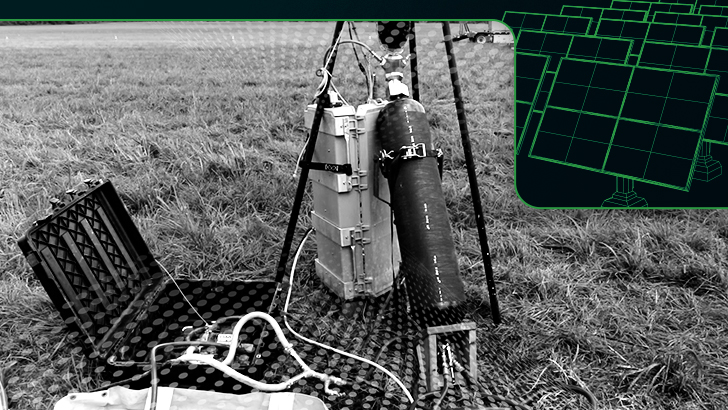

Objective
The purpose of this topic is to develop an on-demand hydrogen generation system that can quickly refuel a vehicle in situations where its main fuel tank is empty.
Description
As the Army moves towards more electrified platforms, new challenges arise, such as running out of fuel or energy while executing a mission. Current vehicles can refuel quickly from a jerrycan, allowing them to travel to the refueling point. Fully electrified platforms cannot easily refuel on the side of the road, which puts both Soldiers and materiel in danger.
Preparing for such situations is important to keep both Soldiers safe and protect next generation platforms. Hydrogen fuel cells are a potential electrification technology that can provide near-silent power and mobility for military vehicles while providing high torque with inherently scalable power and energy, capable of providing range beyond that of purely battery-powered electric vehicles.
Hydrogen can also refuel more quickly than batteries can charge, providing an opportunity to solve the problem of a fuel-depleted vehicle on a mission. There are technologies that exist that can provide hydrogen on-demand from solid materials that can easily and safely be transported and stored. One such technology of interest is aluminum alloys that react with water to provide hydrogen.
Phase I
This is a Direct to Phase II solicitation.
Phase II
Small businesses must design a Hydrogen generation system that is man-portable while providing a meaningful range for vehicles in the instance of fuel depletion. The solution should manage the system’s thermal performance, reducing the exterior touch temperature to safe levels and overall thermal signature.
Companies should also fabricate and demonstrate such a system. Then, they must demonstrate aluminum alloy production capable of supporting the manufacturing of multiple systems. The testing required for this technology will include measuring the flowrate of hydrogen from the system and showing that it can operate at the designed pressure to maintain safe external-touch temperature while removing heat from the reaction.
Phase III
Hydrogen fuel cells offer high-dual-use potential. Users across industries continue to adopt this technology, especially in vehicles and industrial power. The high, compound annual growth rate indicates rapid and significant projected growth throughout a variety of sectors.
Popular use cases for fuel cells in general include power generation for individual and mass-transportation vehicles, industrial processes, data centers, utilities, and residential heating.
Hydrogen fuel cells can build stacks, which allow for modular power systems that can adapt to energy requirements based on the use case. The proposed technology also has potential use within the Army SBIR Program and other Army Research Centers and acquisition programs.
For more information, and to submit your full proposal package, visit the DSIP Portal.

References:
Objective
The purpose of this topic is to develop an on-demand hydrogen generation system that can quickly refuel a vehicle in situations where its main fuel tank is empty.
Description
As the Army moves towards more electrified platforms, new challenges arise, such as running out of fuel or energy while executing a mission. Current vehicles can refuel quickly from a jerrycan, allowing them to travel to the refueling point. Fully electrified platforms cannot easily refuel on the side of the road, which puts both Soldiers and materiel in danger.
Preparing for such situations is important to keep both Soldiers safe and protect next generation platforms. Hydrogen fuel cells are a potential electrification technology that can provide near-silent power and mobility for military vehicles while providing high torque with inherently scalable power and energy, capable of providing range beyond that of purely battery-powered electric vehicles.
Hydrogen can also refuel more quickly than batteries can charge, providing an opportunity to solve the problem of a fuel-depleted vehicle on a mission. There are technologies that exist that can provide hydrogen on-demand from solid materials that can easily and safely be transported and stored. One such technology of interest is aluminum alloys that react with water to provide hydrogen.
Phase I
This is a Direct to Phase II solicitation.
Phase II
Small businesses must design a Hydrogen generation system that is man-portable while providing a meaningful range for vehicles in the instance of fuel depletion. The solution should manage the system’s thermal performance, reducing the exterior touch temperature to safe levels and overall thermal signature.
Companies should also fabricate and demonstrate such a system. Then, they must demonstrate aluminum alloy production capable of supporting the manufacturing of multiple systems. The testing required for this technology will include measuring the flowrate of hydrogen from the system and showing that it can operate at the designed pressure to maintain safe external-touch temperature while removing heat from the reaction.
Phase III
Hydrogen fuel cells offer high-dual-use potential. Users across industries continue to adopt this technology, especially in vehicles and industrial power. The high, compound annual growth rate indicates rapid and significant projected growth throughout a variety of sectors.
Popular use cases for fuel cells in general include power generation for individual and mass-transportation vehicles, industrial processes, data centers, utilities, and residential heating.
Hydrogen fuel cells can build stacks, which allow for modular power systems that can adapt to energy requirements based on the use case. The proposed technology also has potential use within the Army SBIR Program and other Army Research Centers and acquisition programs.
For more information, and to submit your full proposal package, visit the DSIP Portal.
References:
